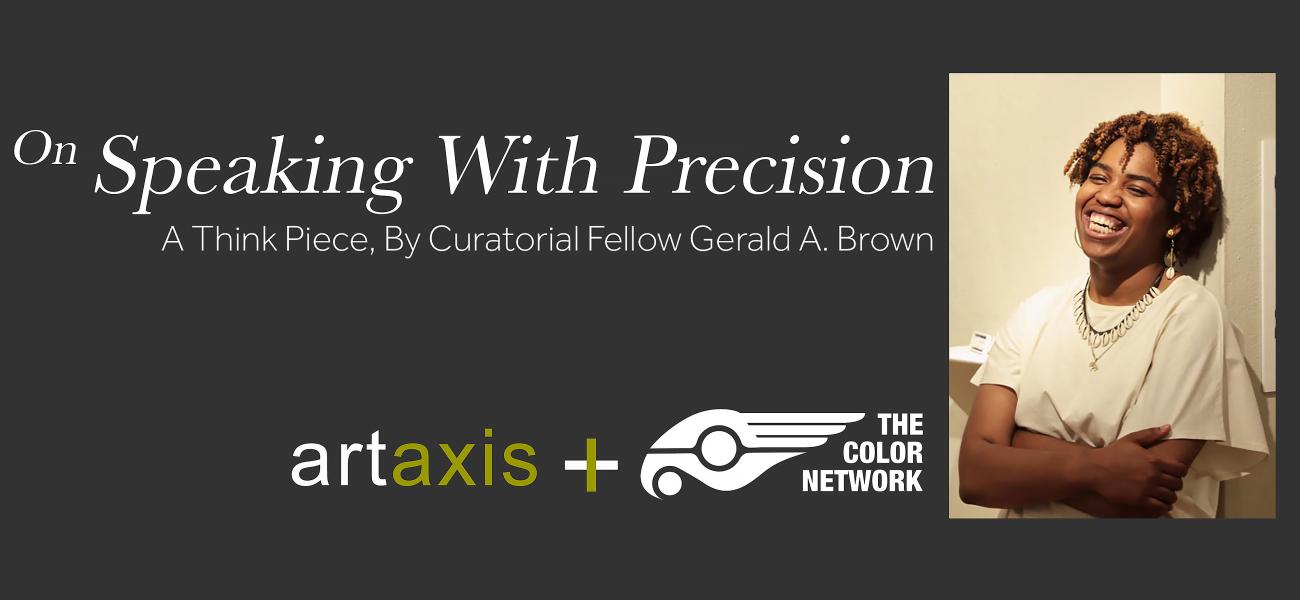On Speaking With Precision
This writing provides insight about the etymology behind the title Speaking with Precision, a virtual exhibition organized in conjunction with the Artaxis + The Color Network Curatorial Fellowship. Complementary to the curatorial statement, this article explores the relevance of the exhibition’s thesis to contemporary issues in the art world. Please visit artaxis.org/precision to see the exhibition and learn more about the individual artists.
How does one speak with precision?
Talking is second nature. People often do not realize there is a great deal of selectivity involved in even the most casual of conversations. To point out the act of speaking with precision can appear redundant and excessive, but within the need to overemphasize there is immense intentionality. This duality of precision prompts the questions:
Who is being perceived to lack selectivity when speaking and has to emphasize their precision to be taken seriously?
Within the spectrum of visual arts, how does the duality of precision appear?
What power dynamics of visual language perpetuate the default vernacular?
What tools and strategies affirm the creative voice of those in question?
Precision can frequently be overrun by publicness and dominating materiality. With ceramic abstraction, artists of color can transform the purpose of precision beyond the scope of responding to being othered. Speaking with Precision, an exhibition celebrating the specificity of language in ceramic abstraction, transcends the limitations of literalness and asks, “How can the aesthetic of abstraction disrupt the politics of normativity and become a vehicle for artists of color to be extremely precise?”
Within Eurocentric spaces, artists of color are publicly celebrated for their ability to entertain external presumptions while simultaneously fulfilling their own desires. Battling otherness, the artist is often weighed down by the need to counter and overexplain. Who is most important in this scenario, the artist (speaker) or the audience (listener)? Does the need to be conscious of the public and their understanding shift the execution of the artist’s idea? Does it influence the artist’s definition of themselves? Most importantly, does the external persona the creator crafts in these spaces match who they are internally?
Kevin Quashie, a philosopher who champions the interior, constantly examines the hyperawareness embedded in questions like the ones above. He actively interrogates how publicness “creeps into the consciousness of the black subject, especially the artist, as the imperative to represent.”1 Conversely, he argues that by focusing on one’s interiority, “desires, ambitions, hungers, vulnerabilities, fears”2 the artist can pivot from being partially public-serving to fully self-expressing. Doing so enables the work to be a direct extension of their core, sustaining and manifesting what is most pertinent to them. This bold and deliberate action to prioritize themselves strengthens the artist’s autonomy. By resisting the demand to negotiate with the audience, the specificity of language becomes less about a viewer’s ability to understand the artist and more about articulation of the artist’s inner self.
In addition to assessing one’s hyperawareness of the public, the artist has to decide which material is the best conduit for their interiority. A rigid substrate requires the artist to apply processes less fluid and connective to the touch. The additional processes forge a barrier between the artist and their making, creating another layer of translation that can dilute the artist's voice. This contention occurs with some materials such as wood or metal that require quite an extensive process to be shaped, creating a barrier between the artist and their making. Though there are defining characteristics to heed, clay is naturally pliable and builds a bond with the creator. Establishing an intimate connection with the artist, the material becomes a mirror of interiority, reflecting vivid concepts and emotions. Following touch, clay responds to every gesture and motion exuded. Beyond many other materials, clay’s ability to reduce friction during making and willingness to return to its original state grants the creator the power to convey deep internal thoughts in their rawest, most unfiltered form. Sometimes, the raw output takes on abstract identity, giving the artist a chance to develop their own language outside the default. The abstract identity inhibits immediate digestion of content. The experience may feel isolating and dissonant to the viewer, as it decenters them as the priority and bestows on the maker tools to own their interiority.
Language can be tricky. When coated with respectability, language becomes a tool designed to serve everyone except the person speaking. But when rooted in interiority, language can be direct and powerful, affirming one’s self and one’s community. It can allow one to speak to nuanced personal and environmental observations without deviating or being interrupted by hyperawareness. Within visual art, an open framework like ceramic abstraction encourages artists, especially Black and Brown, to express a range of complex, vulnerable thoughts. Utilizing an abstract lexicon, the creator has the utmost agency – communicating freely, keenly, and with immense accuracy.
Without a doubt, speaking with precision is a critical part of communicating. When wielded by artists of color, speaking with precision becomes a deadly weapon of choice.
Editor's Note: Artaxis and the Color Network announced that Gerald A. Brown was selected as the 2020-2021 Artaxis + Color Network Curatorial Fellow. This fellowship is a collaboration between the two organizations. The Curatorial Fellowship offers an emerging BIPOC curator the opportunity to realize a virtual exhibition of works by artists listed on Artaxis and/or The Color Network’s websites. The Curatorial Fellow curated an exhibition while working with this year’s Curatorial Mentor, Angelik Vizcarrondo-Laboy. Vizcarrondo-Laboy is an Assistant Curator at the Museum of Arts and Design (MAD), New York and mentored Brown as she curated this exhibition. Brown received a stipend of $500 from Artaxis and the Color Network.
1 Kevin Quashie, The Sovereignty of Quiet: Beyond Resistance in Black Culture (Rutgers University Press, New Brunswick, New Jersey, and London, 2012) 4-6
2 Ibid, 6

